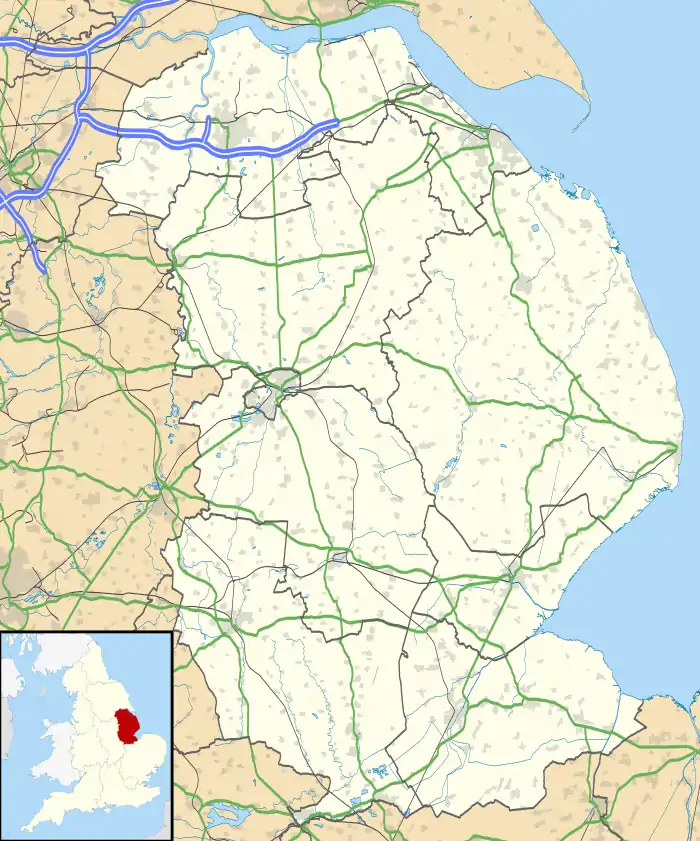| Legbourne | |
|---|---|
 All Saints Church, Legbourne | |
 Legbourne Location within Lincolnshire | |
| Population | 644 (2011 Census)[1] |
| OS grid reference | TF368843 |
| • London | 130 mi (210 km) S |
| Civil parish |
|
| District | |
| Shire county | |
| Region | |
| Country | England |
| Sovereign state | United Kingdom |
| Post town | Louth |
| Postcode district | LN11 |
| Dialling code | 01507 |
| Police | Lincolnshire |
| Fire | Lincolnshire |
| Ambulance | East Midlands |
| UK Parliament | |
Legbourne is a village and civil parish in the East Lindsey district of Lincolnshire, England, about 3 miles (5 km) south-east of the town of Louth.
History
The Priory of Legbourne was founded by Robert Fitz Gilbert of Tathwell about 1150, apparently to receive Cistercian sisters known as the "Nuns of Keddington" (sometimes Haddington).[2] The priory was officially dissolved in 1536, although still occupied by nuns at the time of the Lincolnshire Rising, when they were dragged out by a mob.[2]
The original priory endowment consisted of lands belonging to Robert Fitz Gilberts fee in Tathwell, Legbourne and Hallington, and the churches of Farlesthorpe, Saltfleetby St Peter, Raithby, Hallington, Somercotes and Conisholme, with half that of Legbourne.[2] The priory site is in the grounds of Legbourne Abbey, at present a private house. The only visible remains of the original building are earth mounds.[3]
Governance and population
An electoral ward of the same name stretches north-west to Elkington. It had a population of 1,891 at the 2011 census.[4]
Legbourne's population of 280 in 1801 rose to 511 in 1841, then slowly declined to 347 in 1961. It then rose again to 644 in 2011,[5] and an estimated 653 in 2019.[6]
Landmarks
Legbourne church, built about 1380, is dedicated to All Saints.[7] A Grade I listed building, it was extensively rebuilt in 1865.[8] The church clock was presented by Thomas Cheney Garfitt in 1890.[3] It is a member of the Legbourne Woldmarsh group of rural parishes, acting as its hub. A service of Holy Communion or Matins is held on most Sunday mornings.[9]

The village pump, Grade II listed, is a canopied and pinnacled stone structure in front of the church, built by Canon J. Overton in 1877 in memory of his mother.[10] It was the main supply of water to the village until 1953, when mains water arrived.[3]
Legbourne tower mill, also Grade II listed,[11] was built by Thomas Davy in 1847 after an older post mill burned down. It is now a dwelling.[3]
Legbourne Wood is one of the few ancient woodlands in eastern Lincolnshire and the largest of the Lincolnshire Wildlife Trust woodland nature reserves. The Lincolnshire Trust bought the wood in 2004. Its canopy is ash and oak. Beneath the trees, over 60 species of wild flowers have been recorded, including primrose, early purple orchid, bluebell, wood anemone, sweet woodruff, wood sorrel and lesser celandine.
There is a varied bird population in Legbourne Wood, including one of the largest heronries in the county.[12]
Transport
The village lies on the main A157 road between Louth and Mablethorpe. There are four weekday buses a day between them calling at Legbourne, with connections at Louth for Lincoln.[13]
Legbourne Road railway station was built in 1863 for the Great Northern Railway, but closed in 1970.[14] The level crossing has disappeared, but the station house survives as a private residence.[3] The nearest operating station is at Cleethorpes 21 miles (34 km).
Amenities

Legbourne and Little Cawthorpe Community Centre was built in 1990 as a sports and functions hall. Its playing fields are used also for outdoor events.[15]
The village retains a post office and general store.[3] The Queens Head Inn closed in 2012[16] but re-opened in 2015.[17] Since 1982 there has been a trout farm in the village.[18]
Education
The village has a day nursery and an out-of-school club.[19] East Wold Church of England Primary School, built in 1993, serves Legbourne and surrounding villages.[20]
References
- ↑ "Parish population 2011". Retrieved 20 August 2015.
- 1 2 3 "Victoria County History". Houses of Cistercian Nuns-Priory of Legbourne. British History. Retrieved 19 May 2011.
- 1 2 3 4 5 6 "Legbourne" Village site. Retrieved 19 May 2012.
- ↑ "Ward population 2011". Retrieved 20 August 2015.
- ↑ "Legbourne CP/AP"; Visionofbritain.org.uk. Retrieved 25 August 2011
- ↑ City Population. Retrieved 18 January 2021.
- ↑ "Legbourne All Saints Church"; Lincolnshire.gov.uk. Retrieved 19 May 2011
- ↑ "Church of All Saints, Legbourne"; Britishlistedbuildings.co.uk. Retrieved 19 May 2011.
- ↑ Church of England site .
- ↑ "Pump, Legbourne"; Britishlistedbuildings.co.uk. Retrieved 19 May 2012.
- ↑ "Tower Mill, Legbourne"; Britishlistedbuildings.co.uk. Retrieved 19 May 2011
- ↑ "Legbourne Wood" Archived 25 July 2011 at the Wayback Machine, Lincolnshire Trust. Retrieved 19 May 2011.
- ↑ Bus times. Retrieved 18 January 2021.
- ↑ "Legbourne Disused Station". Disused Stations Website. Retrieved 19 May 2011.
- ↑ "Legbourne & Little Cawthorpe Community Centre"; Lincolnshire Trust. Retrieved 19 May 2011.
- ↑ "Lost pubs in Legbourne". Retrieved 23 April 2012.
- ↑ "Queens Head, Legbourne".
- ↑ "Olsten Trout Farm:: Trout Farm, Fish Farm, Rainbow Trout, Brown Trout, Fishing, Fish Supplies, Lincolnshire, UK".
- ↑ "Red Hen Children's Day Nursery and Kids Crew Out of School Club"; Lincolnshire.gov.uk. Retrieved 19 May 2011
- ↑ "East Wold Church of England Primary School"; Lincolnshire.gov.uk. Retrieved 19 May 2011
External links
 Media related to Legbourne at Wikimedia Commons
Media related to Legbourne at Wikimedia Commons